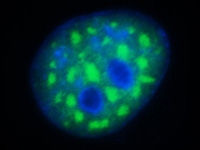Fragile X-associated tremor/ataxia syndrome (FXTAS) is a major cause of ataxia -- lack of muscle movement and coordination -- and tremor in the elderly. The condition is caused by a gene mutation that results in toxic clumps of RNA in the nucleus of brain cells, but the nature of these aggregates has been a mystery. Most researchers have considered them to be some form of amyloid, or clusters of insoluble fibrous material that are permanent in nature. They lead to dysfunction and then death in these cells, resulting in FXTAS neurodegeneration.
To find out what these clumps are, Dr. Samie Jaffrey, an associate professor of pharmacology at Weill Cornell Medical College, decided to "light up" the offending RNA and watch how it works in living brain cells. The results were published in the Oct. 27 issue of Nature Methods.

Toxic RNAs labeled with Spinach2 in the nucleus of cells
In 2011, Dr. Jaffrey pioneered a technique that allows scientists to see RNAs in living cells. It uses an RNA tag called "Spinach" that emits a bright green fluorescence. In the Nature Methods study, Dr. Jaffrey and his colleagues improved this sequence to make it brighter in cells, and called it Spinach2. They engineered cells to express the toxic RNA that is made in FXTAS coupled to a Spinach2 tag. They were then able to observe this RNA in living brain cells.
"Although we saw that the toxic RNAs form aggregates in cells, we also observed that these clumps were highly mobile in the nucleus. This made us ask whether we could disrupt these aggregates using small molecules, and so we screened a small library of compounds to see if that were possible," Dr. Jaffrey says. "When we added one of these compounds, we could see the aggregates dissolve in less than two hours." While the compound they used appeared to be toxic to cells -- and so would not be a good candidate for drug therapy -- the experiment showed that these RNA aggregates can be eliminated from cells, Dr. Jaffrey says.
The RNA imaging technology will help tease apart other mysterious maladies in the brain, he adds. "Many other neurological diseases are caused by RNA aggregates, and our study highlights the possibility that RNA aggregates in diverse diseases can be imaged in living cells," he says. "We can then test the ability of potentially therapeutic small molecules to tear apart these toxic aggregates -- and we can do it in living color."

